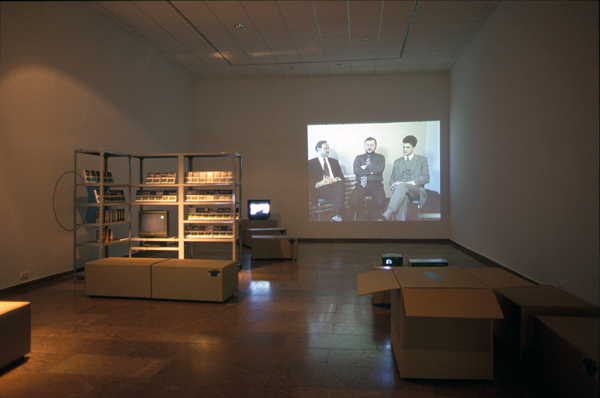The Project Room of the Museum of Contemporary Art – Ludwig Museum Budapest presents from 22 January 2002 the project entitled Transaction of Lithuanian visual artists Nomeda and Gediminas Urbonas.
Nomeda and Gediminas Urbonas have been working together since 1997. In 1993, together with others, they established the Jutempus exhibition space in Vilnius, which functioned until 1996 as a site for exhibitions and cultural events. The projects of Jutempus since then create a framework and serve as a communications base, which, according to their intentions, “transcends the boundaries of the traditional art space and seeks out the media linked to society”.
In the installation Transaction, the viewer meets with a complex mediatised archive. A statement appearing in the Lithuanian media serves as the departure point for the work: a renowned psychoanalyst pronounced in a weekly newspaper that Lithuania, sustaining its attitude which has been recurring throughout history, continues to play the role of a victim even after the political change.
This declaration initiated a complex process of research, which could be best compared to the interdisciplinary methods of anthropologists. At the same time, the most important tool for Nomeda and Gediminas Urbonas is communication, and thus, their personal discussions influenced and guided the method and direction of research.
The artists employed an applied model of the “transactional analysis” method introduced by American psychologist Eric Berne toward the presentation of the correlations between the collected materials. According to the dramatic triangular model, over the course of our lives, we move between the roles of the prosecutor, the rescuer and the victim, or i.e., we play the various roles of a mental script.
The first part of the work comprises an interview series presented on two TV sets, in which Lithuanian intellectual women confess about themselves, the evolution of their world concept and their identities. According to their narratives, the girls interviewed have transcended their traditional female roles. Their conscious undertaking of their roles is counterposed with the lack of initiative in the female roles of Lithuanian feature films that they often mention as a reference.
In the second part of the installation – likewise presented on TV monitors – we can see the mentioned female roles of popular Lithuanian feature films. The selected scenes render visible that in the majority of cases, women play the subordinate role, filling the part of protectress or the depraving, while in many films they appear as the picture of the little girl in the polka-dot dress that expresses innocence and lack of initiative.
The third part of the work, which we see in monumental format projected to the wall, presents the discussion of a group of Lithuanian psychoanalysts, who upon viewing the selected scenes of the Lithuanian feature films, analyse the collective unconscious script established through the films. While the psychoanalysts analyse the scenes – reproducing the positions of the traditional gender roles in their argumentation – they themselves are simultaneously transformed into an analysable picture.
Transaction raises numerous questions, which the viewer can approach from various viewpoints, rambling between the different levels. How does it influence the individual, if society lives the role of the victim? What is the connection between the image generated of women and the roles that women live in reality? How should we discern the reality that is transmitted via moving images?
Accompanying the Budapest exhibition vernissage is a symposium, in which Lithuanian and Hungarian participants discuss the questions raised in the work. The artists record the event composed of short lectures and discussion, as a new analytical level of Transaction. By means of examining issues of identity and gender in society the symposium provides the possibility for a comparison of the situations in the two post-Socialist countries.
Vernissage and symposium: 7 p.m., 22 January 2002
Erzsébet Barát, linguist:
Falling Back on Deaf Ears
Dalia Marcinkeviciene, historian:
Men, Women and Soviet Ideology
Erika Grigoreviciene, art critic, curator:
Media and Gender Policy. Lithuanian Pecularities
Laima Kreyvite, art critic, curator:
Women’s Scenarios from Sculpture to TV shows
Éva Bicskei, art historian: Visual Auto(-Biographies) – Fictive Identities
Katalin Lévai, sociologist: Private History of Women
The language of the symposium is English.
THE REALISATION OF THE SYMPOSIUM WAS MADE POSSIBLE WITH THE SUPPORT OF THE CULTURAL LINK PROGRAM OF THE SOROS FOUNDATION

